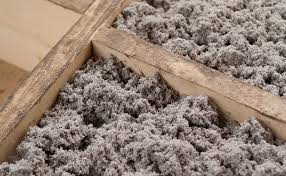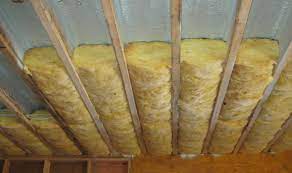Attic Insulation
January 2023
Choose Your Insulation Type and Material
1. Loose fill
Insulation fibers are packaged in bags and blown in place to the desired depth and density using special machinery you can rent from a home center. You can pour the fill in place and spread it manually, but the process is much more labor-intensive and the results won’t be nearly as good.

It works best for:
- Attics with irregular or nonstandard joist spacing
- Attics with lots of obstructions and penetrations to work around
- Attics where there is existing insulation to be topped since it fills gaps and joints well
- Low-clearance attics with limited headroom for maneuvering during installation
- DIYers who want to get the job done quickly and are comfortable working with power equipment
2. Batts
This flexible insulation material is most often packaged in rolls that come in various thicknesses and standard widths, usually 16 inches and 24 inches, to fit between joists or studs in a house’s framing. They come with or without a paper or foil facing that acts as a vapor barrier. You add one or more layers to achieve the desired level of insulation.

They work best for:
- Attics with standard joist spacing, especially those with no insulation
- Attics with few obstructions or penetrations to work around
- Attics with sufficient headroom for maneuvering during installation
- DIYers who don’t mind cutting the material to fit around obstructions
Size Up Your Existing Insulation (and Get Rid of The Bad Stuff)
:no_upscale()/cdn.vox-cdn.com/uploads/chorus_asset/file/19509086/05_attic_insul.jpg)
Grab a tape measure and a flashlight to see what kind of insulation you already have in the attic and how deep it is. Then use the numbers in the chart at right to estimate its R-value. Pull up and dispose of any material that’s compressed, water stained, or moldy—it’s useless.
Owners of houses built before 1990 take note: If what you see is lightweight, grainy, loose-looking insulation with shiny flecks, it could be vermiculite from a mine with asbestos deposits. Get it tested, and if necessary, call in a pro to remove and haul it away safely.
Determine Your Target R-value
The Department of Energy recommends these minimum R-values for unfinished, unconditioned attics. The numbers are based on your house’s location and climate zone.
:no_upscale()/cdn.vox-cdn.com/uploads/chorus_asset/file/19509155/06_attic_insul.jpg)
Courtesy of Department of Energy
Types of Insulation
| TYPE | MATERIAL | WHERE APPLICABLE | INSTALLATION METHODS | ADVANTAGES |
|---|---|---|---|---|
| Blanket: batts and rolls | Fiberglass
Mineral (rock or slag) wool Plastic fibers Natural fibers |
Unfinished walls, including foundation walls
Floors and ceilings |
Fitted between studs, joists, and beams. | Do-it-yourself.
Suited for standard stud and joist spacing that is relatively free from obstructions. Relatively inexpensive. |
| Concrete block insulation
and insulating concrete blocks |
Foam board, to be placed on outside of wall (usually new construction) or inside of wall (existing homes):
Some manufacturers incorporate foam beads or air into the concrete mix to increase R-values |
Unfinished walls, including foundation walls
New construction or major renovations Walls (insulating concrete blocks) |
Require specialized skills
Insulating concrete blocks are sometimes stacked without mortar (dry-stacked) and surface bonded. |
Insulating cores increases wall R-value.
Insulating outside of concrete block wall places mass inside conditioned space, which can moderate indoor temperatures. Autoclaved aerated concrete and autoclaved cellular concrete masonry units have 10 times the insulating value of conventional concrete. |
| Foam board or rigid foam | Polystyrene
Polyisocyanurate Polyurethane Phenolic |
Unfinished walls, including foundation walls
Floors and ceilings Unvented low-slope roofs |
Interior applications: must be covered with 1/2-inch gypsum board or other building-code approved material for fire safety.
Exterior applications: must be covered with weatherproof facing. |
High insulating value for relatively little thickness.
Can block thermal short circuits when installed continuously over frames or joists. |
| Insulating concrete forms (ICFs) | Foam boards or foam blocks | Unfinished walls, including foundation walls for new construction | Installed as part of the building structure. Cores in the blocks are typically filled with concrete to create the structural component of the wall. | Insulation is literally built into the home’s walls, creating high thermal resistance. |
| Loose-fill and blown-in | Cellulose
Fiberglass Mineral (rock or slag) wool |
Enclosed existing wall or open new wall cavities
Unfinished attic floors Other hard-to-reach places |
Blown into place using special equipment and, although not recommended, sometimes poured in. | Good for adding insulation to existing finished areas, irregularly shaped areas, and around obstructions. |
| Reflective system | Foil-faced kraft paper, plastic film, polyethylene bubbles, or cardboard | Unfinished walls, ceilings, and floors | Foils, films, or papers fitted between wood-frame studs, joists, rafters, and beams. | Do-it-yourself.
Suitable for framing at standard spacing. Bubble-form suitable if framing is irregular or if obstructions are present. Most effective at preventing downward heat flow, effectiveness depends on spacing and number of foils. |
| Rigid fibrous or fiber insulation | Fiberglass
Mineral (rock or slag) wool |
Ducts in unconditioned spaces
Other places requiring insulation that can withstand high temperatures |
HVAC contractors fabricate the insulation into ducts either at their shops or at the job sites. | Can withstand high temperatures. |
| Sprayed foam and foamed-in-place | Cementitious
Phenolic Polyisocyanurate Polyurethane |
Enclosed existing wall
Open new wall cavities Unfinished attic floors |
Applied using small spray containers or in larger quantities as a pressure sprayed (foamed-in-place) product. | Good for adding insulation to existing finished areas, irregularly shaped areas, and around obstructions. |
| Structural insulated panels (SIPs) | Foam board or liquid foam insulation core
Straw core insulation |
Unfinished walls, ceilings, floors, and roofs for new construction | Construction workers fit SIPs together to form walls and roof of a house. | SIP-built houses provide superior and uniform insulation compared to more traditional construction methods; they also take less time to build. |
Courtesy of https://www.energy.gov/energysaver/types-insulation
Goodman, M. (n.d.). Read This Before You Insulate Your Attic. This Old House. Retrieved January 11, 2023, from https://www.thisoldhouse.com/insulation/21018131/read-this-before-you-insulate-your-attic
